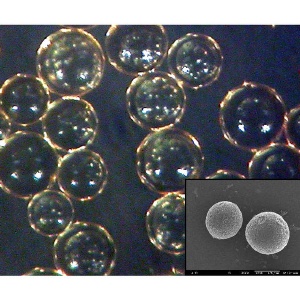May 14 2009
Replacing hazardous solvents with water and improving efficiencies are ways that chemists can reduce the environmental impact of their reactions-a central goal of the 'green chemistry' movement. Now, Yasuhiro Uozumi and colleagues from the RIKEN Advanced Science Institute in Wako have developed recyclable catalysts that selectively generate chiral organic molecules in water*-a nearly ideal green chemical process.
 Optical microscopy and electron microscopy (inset) images of the polystyrene–polyethylene catalyst beads.
Optical microscopy and electron microscopy (inset) images of the polystyrene–polyethylene catalyst beads.
Chiral compounds are molecules that contain an asymmetric site in their structure. This asymmetry means that two enantiomers, molecules that are chemically identical but organized so that they are mirror images of each other, are found for each chiral substance. Because enantiomers can have drastically different properties-one may be therapeutic while the other is toxic, for example-it is crucial for chemists to be able to control the chirality of their reactions.
Uozumi's group specializes in the technique of asymmetric catalysis, in which a chiral metal catalyst is used to generate specific enantiomers with high yields and little waste. In their latest work, the researchers have discovered how to couple two naphthalene-based molecules into a single chiral compound by using a specially designed palladium catalyst.
The catalyst developed by Uozumi contained a large chiral molecule, named imidazoindole phosphine, which forms a complex around the palladium metal. The geometry of this catalyst allows only one enantiomer type to emerge from the coupling reaction. The researchers found that the catalyzed reaction was up to 94% selective, and could be performed with a wide range of starting materials.
"High enantiomer selectivity is seen because the imidazoindole ligands provide a rigid and effective chiral environment," says Uozumi. "And, the catalyst has high activity because of the bulky and basic phosphine substituents attached to palladium."
Next, Uozumi's team attached the palladium catalysts to very small polystyrene-polyethylene beads so that they could perform the chiral coupling in a water medium. The solid polymer supports made the catalysts easily recyclable and preserved the catalyst activity in an aqueous environment.
"The polymer support helps the catalyst become water-compatible, which is the key to driving the catalysis in water," says Uozumi. The researchers found that the catalytic coupling performed just as well in water as in a traditional organic solvent.
According to Uozumi, tightening regulatory environments make the development of sustainable chemical reactions, like his water-based catalysis, a true necessity. "Meeting 'green' and safe chemical requirements is rapidly becoming very important in the field of chemical processes," he says.
*Uozumi, Y., Matsuura, Y., Arakawa, T. & Yamada, Y.M.A. Asymmetric Suzuki-Miyaura coupling in water with a chiral palladium catalyst supported on an amphiphilic resin. Angewandte Chemie International Edition 48, 2708-2710 (2009).